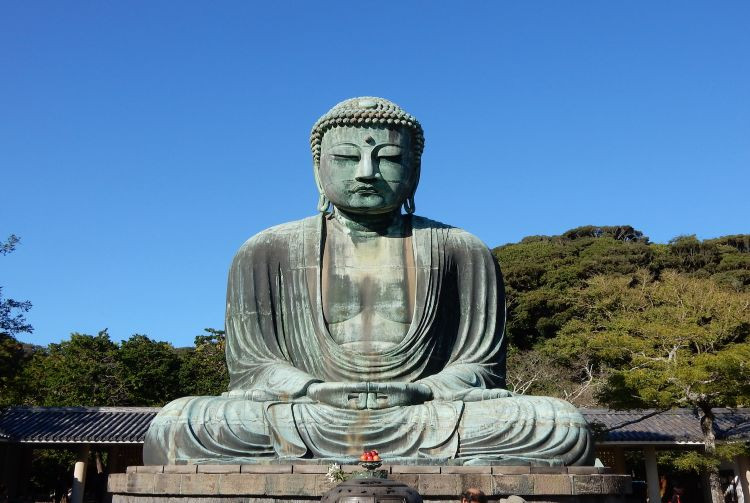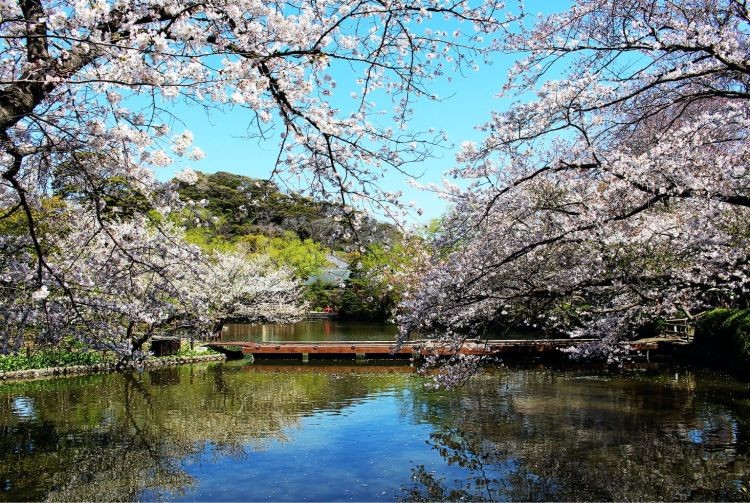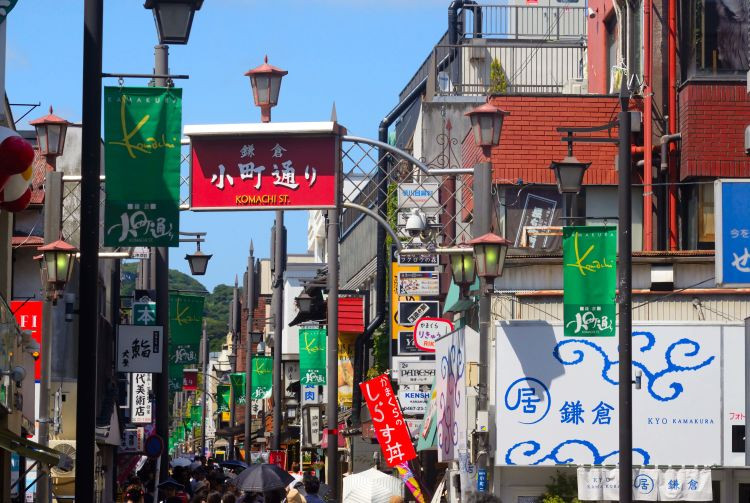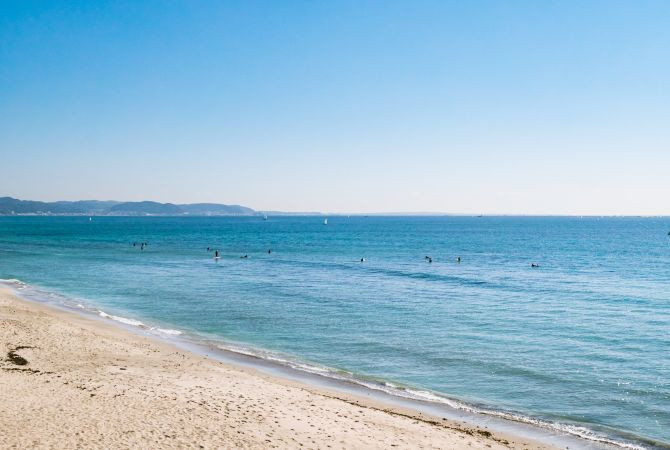Kamakura Tourism offers a unique blend of historical significance, natural beauty, and accessibility, making it a worthwhile destination. SIXT.VN provides comprehensive travel solutions to make your Kamakura exploration seamless, offering services ranging from airport transfers to curated tours that unlock the essence of this enchanting city. Discover Zen temples, iconic landmarks, and breathtaking coastal views with ease.
1. What Makes Kamakura a Must-Visit Destination for Tourists?
Kamakura is a must-visit destination due to its rich history as the former political capital of Japan, stunning temples, and scenic coastal location. It offers a unique blend of cultural immersion and natural beauty, easily accessible from Tokyo. According to the Kamakura City Tourist Association, the city attracts visitors year-round with its seasonal flowers and historical sites.
- Historical Significance: As the seat of the Kamakura Shogunate from 1185 to 1333, the city boasts numerous historical sites. These sites provide insight into Japan’s feudal past. The influence of Zen Buddhism is particularly evident in the architecture and serene atmosphere of many temples.
- Temples and Shrines: Kamakura is home to some of Japan’s most beautiful and historically significant temples and shrines. These include the iconic Kotoku-in Temple, home to the Great Buddha, and Tsurugaoka Hachimangu Shrine, a symbol of the city.
- Coastal Location: Situated on the coast, Kamakura offers beautiful beaches and stunning views of the Pacific Ocean. The beaches of Yuigahama and Zaimokuza are popular destinations for swimming, sunbathing, and surfing during the summer months.
- Accessibility: Kamakura is easily accessible from Tokyo, making it a popular day trip destination for both domestic and international tourists. Direct train services connect the city to major transportation hubs, making it convenient to visit.
- Cultural Experience: Kamakura provides a unique opportunity to experience Japanese culture and traditions. Visitors can explore traditional gardens, participate in tea ceremonies, and sample local cuisine. The city also hosts numerous festivals and events throughout the year.
2. What Are the Top Attractions I Shouldn’t Miss in Kamakura?
You shouldn’t miss the Great Buddha at Kotoku-in Temple, Tsurugaoka Hachimangu Shrine, and the serene Zen gardens of the Kamakura Gozan temples. Additionally, explore the Komachi-dori shopping street and the scenic Enoshima Island for a diverse Kamakura experience. According to TripAdvisor, these are consistently ranked as the most popular attractions among visitors.
- The Great Buddha (Daibutsu) at Kotoku-in Temple: This iconic bronze statue is one of the most famous landmarks in Japan. Visitors can even go inside the statue to explore its interior.
- Tsurugaoka Hachimangu Shrine: This important Shinto shrine is dedicated to the god of war and is a symbol of the city. The shrine complex includes several buildings, gardens, and a museum.
- Kamakura Gozan Temples: These five Zen temples are renowned for their beautiful gardens and tranquil atmosphere. They include Kencho-ji, Engaku-ji, Jufuku-ji, Jochi-ji, and Jomyo-ji.
- Hasedera Temple: This temple is famous for its eleven-headed statue of Kannon, the goddess of mercy, and its beautiful gardens overlooking the ocean.
- Komachi-dori Street: This bustling shopping street is lined with shops selling local crafts, souvenirs, and food. It’s a great place to experience the local culture and sample regional specialties.
- Enoshima Island: Connected to the mainland by a bridge, Enoshima Island offers stunning views, scenic gardens, and a variety of attractions, including the Enoshima Shrine and the Enoshima Sea Candle lighthouse.
- Zeniarai Benten Shrine: This unique shrine is known for its spring water, which is said to bring good fortune to those who wash their money in it.
- Yuigahama Beach: This popular beach is a great place to relax, swim, and enjoy the ocean views. It’s also a popular spot for surfing.
- Kamakura Museum of Literature: This museum is dedicated to the literary history and features exhibits on famous writers who lived in or were inspired by the city.
- Hokokuji Temple (Bamboo Temple): Known for its stunning bamboo grove, this temple offers a tranquil escape from the hustle and bustle of the city.
 The Great Buddha of Kamakura, a monumental bronze statue, standing serenely amidst lush greenery.
The Great Buddha of Kamakura, a monumental bronze statue, standing serenely amidst lush greenery.
3. How Can I Get to Kamakura from Tokyo?
You can get to Kamakura from Tokyo in approximately 55 minutes via the JR Yokosuka Line, making it an easily accessible day trip. SIXT.VN can arrange convenient transportation services, ensuring a smooth and stress-free journey. According to Japan National Tourism Organization (JNTO), this is the most direct and efficient way to reach Kamakura by train.
- JR Yokosuka Line: The JR Yokosuka Line is the most direct and convenient way to travel from Tokyo to Kamakura. The train departs from Tokyo Station and Shinagawa Station. It takes approximately 55 minutes to reach Kamakura Station.
- JR Shonan-Shinjuku Line: The JR Shonan-Shinjuku Line also connects Tokyo (Shinjuku Station) to Kamakura. However, it may take slightly longer than the JR Yokosuka Line.
- Odakyu Enoshima-Kamakura Free Pass: If you plan to visit Enoshima as well, consider purchasing the Odakyu Enoshima-Kamakura Free Pass. This pass includes round-trip transportation from Shinjuku Station to Fujisawa Station (the gateway to Enoshima) on the Odakyu Line, as well as unlimited travel on the Enoshima Electric Railway (Enoden) and certain Odakyu buses in the Kamakura and Enoshima areas.
- By Car: You can also drive to Kamakura from Tokyo. However, be aware that traffic can be heavy, especially on weekends and holidays. Parking in Kamakura can also be limited and expensive.
- By Bus: Highway buses also operate between Tokyo and Kamakura. However, the journey time can be longer than by train, depending on traffic conditions.
- SIXT.VN Private Transfer: For a hassle-free experience, SIXT.VN offers private transfer services from Tokyo to Kamakura. This option provides door-to-door service and allows you to relax and enjoy the journey.
4. What Are the Best Times to Visit Kamakura for Scenic Views?
The best times to visit Kamakura for scenic views are during the spring for cherry blossoms and autumn for vibrant foliage. These seasons enhance the beauty of the temples and gardens. According to the Kamakura City Tourist Association, cherry blossoms typically bloom in late March to early April, while autumn foliage is at its peak from mid-November to early December.
- Spring (Late March to Early April):
- Cherry Blossoms (Sakura): The city is awash in pink and white as cherry blossoms bloom in temples, parks, and along riverbanks. Popular spots for cherry blossom viewing include Tsurugaoka Hachimangu Shrine, Kencho-ji Temple, and the banks of the Tsurugaoka Hachimangu.
- Pleasant Weather: Spring offers mild temperatures and sunny skies, making it ideal for exploring the outdoors.
- Autumn (Mid-November to Early December):
- Autumn Foliage (Koyo): The leaves of maple trees and other deciduous trees turn vibrant shades of red, orange, and yellow, creating a stunning spectacle. Popular spots for autumn foliage viewing include Hasedera Temple, Engaku-ji Temple, and the Kamakura Botanical Garden.
- Cool and Crisp Air: Autumn offers cool and crisp air, perfect for hiking and enjoying the natural beauty.
- Other Times to Consider:
- Summer (July to August): The summer months are popular for visiting the beaches of Kamakura. However, it can be hot and humid.
- Winter (December to February): Winter offers clear skies and fewer crowds. However, it can be cold.
5. What Unique Cultural Experiences Can I Enjoy in Kamakura?
In Kamakura, you can enjoy unique cultural experiences such as visiting Zen temples for meditation, participating in a traditional tea ceremony, and exploring local festivals. These experiences offer a deep dive into Japanese traditions. According to Japan Experience, these cultural activities are essential for understanding the soul of Kamakura.
- Zen Temple Meditation (Zazen):
- Engaku-ji Temple: Offers Zazen meditation sessions for visitors.
- Kencho-ji Temple: Provides opportunities for Zen meditation practice.
- Benefits: Experience mindfulness, reduce stress, and gain insight into Zen Buddhism.
- Traditional Tea Ceremony (Chado):
- Various Tea Houses: Several tea houses in Kamakura offer tea ceremony experiences.
- Learn Etiquette: Discover the proper etiquette and customs of the tea ceremony.
- Enjoy Matcha: Savor the taste of freshly prepared matcha green tea and traditional sweets.
- Exploring Local Festivals (Matsuri):
- Kamakura Festival (April): Features traditional dances, music, and historical reenactments.
- Tsurugaoka Hachimangu Reitaisai Festival (September): Showcases the art of horseback archery (Yabusame).
- Experience Festivities: Immerse yourself in the vibrant atmosphere, sample local foods, and witness traditional performances.
- Visiting Traditional Gardens:
- Hasedera Temple Garden: A beautiful hillside garden with stunning ocean views.
- Kamakura Botanical Garden: Features a diverse collection of plants and flowers.
- Enjoy Serenity: Stroll through peaceful gardens and appreciate the harmony of nature.
- Trying Local Cuisine:
- Shirasu Don: A rice bowl topped with fresh whitebait (shirasu), a local specialty.
- Kamakura Vegetables: Sample locally grown vegetables at farmers’ markets and restaurants.
- Enjoy Flavors: Discover the unique flavors of Kamakura cuisine.
- Exploring Traditional Crafts:
- Kamakura-bori Carving: Visit workshops and galleries showcasing this traditional wood carving technique.
- Purchase Souvenirs: Find unique handcrafted souvenirs to take home.
 A vibrant display of traditional Japanese culture at Tsurugaoka Hachimangu Shrine, featuring intricate architectural details and lush greenery.
A vibrant display of traditional Japanese culture at Tsurugaoka Hachimangu Shrine, featuring intricate architectural details and lush greenery.
6. Are There Any Hidden Gems or Less Crowded Spots in Kamakura?
Yes, some hidden gems in Kamakura include the Hokokuji Temple (Bamboo Temple) and the Zeniarai Benten Shrine. These spots offer tranquility and unique experiences away from the main tourist crowds. According to local travel blogs, these locations provide a more intimate and authentic experience.
- Hokokuji Temple (Bamboo Temple):
- Bamboo Grove: A serene and enchanting bamboo grove provides a tranquil escape.
- Matcha Tea: Enjoy a cup of matcha tea in a traditional teahouse surrounded by bamboo.
- Fewer Crowds: Offers a more peaceful atmosphere compared to more popular temples.
- Zeniarai Benten Shrine:
- Money Washing: Wash your money in the shrine’s spring water, said to bring good fortune.
- Unique Experience: A unique and memorable cultural experience.
- Off the Beaten Path: Located in a secluded area, away from the main tourist trails.
- Ankokuronji Temple:
- Scenic Views: Offers panoramic views of Kamakura and the coastline.
- Historical Significance: A temple with a rich history and cultural significance.
- Less Visited: Often overlooked by tourists, providing a quieter experience.
- Jochi-ji Temple:
- Engraved Tunnel: Features a unique tunnel carved into the rock, adorned with Buddhist statues.
- Beautiful Gardens: Surrounded by lush gardens and serene landscapes.
- Hidden Gem: A lesser-known temple with a charming atmosphere.
- Kamakura Museum of Literature:
- Literary History: Dedicated to the literary history and features exhibits on famous writers who lived in or were inspired by the city.
- Quiet Atmosphere: Offers a peaceful and contemplative environment.
- Cultural Insight: Provides a unique perspective on Kamakura’s cultural heritage.
- Hiking Trails:
- Daibutsu Hiking Trail: Connects the Great Buddha to other temples and shrines through scenic hiking trails.
- Gionyama Park: Offers panoramic views of Kamakura and the surrounding area.
- Nature Escape: Provides an opportunity to escape the city and enjoy the natural beauty of the area.
7. What Local Food Should I Try While Visiting Kamakura?
While visiting Kamakura, you should try Shirasu Don (whitebait rice bowl), Kamakura vegetables, and local seafood. These foods offer a taste of the region’s culinary specialties. According to Gurunavi, these dishes are highly recommended for experiencing local flavors.
- Shirasu Don (Whitebait Rice Bowl):
- Fresh Whitebait: A rice bowl topped with fresh, translucent whitebait (shirasu), a local specialty.
- Seasonal Dish: Best enjoyed during the spring and autumn seasons when whitebait is at its freshest.
- Local Favorite: A popular dish among locals and tourists alike.
- Kamakura Vegetables:
- Locally Grown: Sample locally grown vegetables at farmers’ markets and restaurants.
- Seasonal Produce: Enjoy seasonal produce, such as tomatoes, cucumbers, and eggplants, grown in the fertile soil of the area.
- Farm-to-Table: Experience the fresh flavors of farm-to-table cuisine.
- Local Seafood:
- Fresh Catch: Kamakura’s coastal location offers a wide variety of fresh seafood.
- Sushi and Sashimi: Enjoy sushi and sashimi made with locally caught fish.
- Grilled Seafood: Sample grilled seafood dishes at restaurants along the coast.
- Kamakura Curry:
- Unique Blend: A curry dish with a unique blend of spices and local ingredients.
- Local Interpretation: A local interpretation of the popular Japanese curry.
- Comfort Food: A comforting and flavorful dish.
- Kamakura Beer:
- Microbrewery: Sample locally brewed craft beer at a microbrewery in Kamakura.
- Unique Flavors: Enjoy unique flavors and varieties of beer.
- Local Craft: A refreshing way to experience the local craft beer scene.
- Sweets and Desserts:
- Kamakura Mochi: A soft and chewy rice cake filled with sweet red bean paste.
- Green Tea Ice Cream: Enjoy refreshing green tea ice cream at local cafes.
- Traditional Treats: Sample other traditional Japanese sweets and desserts.
 A colorful spread of local delicacies in Kamakura, featuring fresh seafood, vibrant vegetables, and traditional sweets, showcasing the region's culinary diversity.
A colorful spread of local delicacies in Kamakura, featuring fresh seafood, vibrant vegetables, and traditional sweets, showcasing the region's culinary diversity.
8. What Accommodation Options Are Available in Kamakura?
Kamakura offers a range of accommodation options, including traditional Ryokans, modern hotels, and guesthouses. SIXT.VN can assist in booking accommodations that suit your preferences and budget. According to Booking.com, there is a variety of choices to fit different travel styles.
- Ryokans (Traditional Japanese Inns):
- Traditional Experience: Experience traditional Japanese hospitality and culture.
- Tatami Mats: Sleep on tatami mats in traditional Japanese rooms.
- Onsen Baths: Enjoy relaxing in onsen (hot spring) baths.
- Kaiseki Dinner: Savor a multi-course kaiseki dinner featuring local ingredients.
- Hotels:
- Modern Amenities: Enjoy modern amenities and comfortable accommodations.
- Variety of Options: Choose from a variety of hotels, ranging from budget-friendly to luxury.
- Convenient Locations: Hotels are often located near train stations and popular attractions.
- Guesthouses:
- Budget-Friendly: A more affordable option for budget-conscious travelers.
- Social Atmosphere: A social atmosphere where you can meet other travelers.
- Local Experience: Offers a more local and authentic experience.
- Vacation Rentals:
- Apartments and Houses: Rent an apartment or house for a more independent and spacious stay.
- Home-Like Comforts: Enjoy home-like comforts, such as a kitchen and laundry facilities.
- Suitable for Families: A good option for families or groups traveling together.
- Temple Stays (Shukubo):
- Unique Experience: Experience a unique temple stay at a Buddhist temple.
- Simple Accommodations: Simple accommodations with shared facilities.
- Meditation and Chanting: Participate in morning meditation and chanting sessions.
- Capsule Hotels:
- Budget-Friendly: A very affordable option for solo travelers.
- Compact Pods: Sleep in compact, capsule-like pods.
- Minimalist Style: A minimalist and futuristic style of accommodation.
9. What Are Some Family-Friendly Activities in Kamakura?
Some family-friendly activities in Kamakura include visiting the Great Buddha, exploring Tsurugaoka Hachimangu Shrine, and spending time at Yuigahama Beach. These offer engaging experiences for all ages. According to travel blogs focused on family travel, these are top picks for families visiting Kamakura.
- Visiting the Great Buddha (Daibutsu) at Kotoku-in Temple:
- Iconic Landmark: A memorable experience for children to see the giant bronze Buddha statue.
- Photo Opportunities: Great photo opportunities for family memories.
- Educational Experience: An opportunity to learn about Buddhist culture and history.
- Exploring Tsurugaoka Hachimangu Shrine:
- Historical Site: A historical shrine with beautiful architecture and gardens.
- Wide Open Spaces: Plenty of space for children to run and play.
- Pond with Koi Fish: A pond with colorful koi fish that children will enjoy watching.
- Spending Time at Yuigahama Beach:
- Sandy Beach: A sandy beach perfect for building sandcastles and playing in the water.
- Swimming and Surfing: Opportunities for swimming and surfing (with supervision).
- Beachside Restaurants: Restaurants and cafes with family-friendly menus.
- Riding the Enoshima Electric Railway (Enoden):
- Scenic Train Ride: A scenic train ride along the coast, passing through charming towns and villages.
- Fun for All Ages: An enjoyable experience for children and adults alike.
- Access to Enoshima Island: Connects to Enoshima Island, another family-friendly destination.
- Visiting Kamakura Children’s Museum:
- Interactive Exhibits: Interactive exhibits designed for children to learn through play.
- Educational Activities: Educational activities and workshops for children of all ages.
- Fun and Engaging: A fun and engaging way for children to learn about science, technology, and culture.
- Exploring Enoshima Island:
- Enoshima Sea Candle (Lighthouse): Climb to the top of the Enoshima Sea Candle for panoramic views.
- Enoshima Aquarium: Discover marine life at the Enoshima Aquarium.
- Enoshima Samuel Cocking Garden: A botanical garden with colorful flowers and plants.
 A family enjoys a sunny day at Yuigahama Beach in Kamakura, building sandcastles and playing by the sea.
A family enjoys a sunny day at Yuigahama Beach in Kamakura, building sandcastles and playing by the sea.
10. How Can SIXT.VN Enhance My Kamakura Tourism Experience?
SIXT.VN enhances your Kamakura tourism experience by providing seamless airport transfers, comfortable hotel bookings, and expertly curated tours. Our services ensure a stress-free and memorable visit to Kamakura. We offer personalized travel solutions to meet your specific needs.
- Airport Transfers:
- Hassle-Free Arrival: Start your trip with a hassle-free airport transfer from Narita (NRT) or Haneda (HND) airports to your hotel in Kamakura.
- Comfortable and Reliable: Enjoy a comfortable and reliable private transfer with professional drivers.
- Avoid Public Transportation: Avoid the stress of navigating public transportation with luggage.
- Hotel Bookings:
- Wide Selection: Choose from a wide selection of hotels, ryokans, and guesthouses in Kamakura.
- Best Rates: Get the best rates on accommodations with SIXT.VN’s booking service.
- Personalized Recommendations: Receive personalized recommendations based on your preferences and budget.
- Curated Tours:
- Expert Guides: Join expertly curated tours led by knowledgeable local guides.
- Unique Itineraries: Discover hidden gems and off-the-beaten-path attractions.
- Cultural Immersion: Immerse yourself in the local culture and traditions.
- Transportation Services:
- Private Car Rental: Rent a private car for convenient transportation around Kamakura and the surrounding area.
- Flexible Itinerary: Enjoy the flexibility of creating your own itinerary and exploring at your own pace.
- Professional Drivers: Hire a professional driver for a more relaxed and stress-free experience.
- Travel Planning Assistance:
- Personalized Itineraries: Receive personalized travel itineraries tailored to your interests and preferences.
- Expert Advice: Get expert advice on the best time to visit, what to see, and where to eat.
- 24/7 Support: Enjoy 24/7 customer support throughout your trip.
- Multi-Lingual Support:
- English-Speaking Staff: Communicate with our English-speaking staff for assistance with bookings and inquiries.
- Seamless Communication: Enjoy seamless communication and hassle-free service.
SIXT.VN: Your Gateway to Unforgettable Kamakura Adventures
Ready to experience the enchanting blend of history, culture, and natural beauty that Kamakura offers? SIXT.VN is your trusted partner in crafting the perfect Kamakura getaway. We understand the challenges of planning a trip to a foreign country, from navigating transportation to finding the right accommodations. That’s why we offer a comprehensive suite of services designed to make your journey seamless and stress-free.
-
Eliminate Planning Headaches:
Let us take care of the details, so you can focus on creating unforgettable memories.
-
Unlock Local Expertise:
Benefit from our in-depth knowledge of Kamakura and its hidden gems.
-
Enjoy Personalized Service:
We tailor our services to meet your unique needs and preferences.
Don’t let the complexities of travel planning hold you back. Contact SIXT.VN today and let us help you design the Kamakura adventure of your dreams. Visit our website at SIXT.VN or call our hotline/WhatsApp at +84 986 244 358 to start planning your trip. Our address is 260 Cau Giay, Hanoi, Vietnam.
FAQ About Kamakura Tourism
1. Is Kamakura worth visiting as a day trip from Tokyo?
Yes, Kamakura is definitely worth visiting as a day trip from Tokyo. It’s easily accessible by train and offers a wealth of historical and cultural attractions.
2. What is Kamakura best known for?
Kamakura is best known for the Great Buddha statue, its numerous Zen temples, and its historical significance as the former political capital of Japan.
3. How much time do I need to see Kamakura?
You can see the main attractions in Kamakura in one day, but spending two days allows for a more relaxed and in-depth exploration.
4. Is Kamakura expensive to visit?
Kamakura is moderately priced. Accommodation and transportation can be affordable, and there are many free or low-cost attractions.
5. What is the best way to get around Kamakura?
The best way to get around Kamakura is by train, bus, or on foot. The Enoshima Electric Railway (Enoden) is a scenic and convenient option.
6. What souvenirs should I buy in Kamakura?
Popular souvenirs from Kamakura include Kamakura-bori wood carvings, local sweets, and crafts related to temples and shrines.
7. Are there any vegetarian or vegan options in Kamakura?
Yes, many restaurants in Kamakura offer vegetarian and vegan options. Look for dishes featuring tofu, vegetables, and rice.
8. Is it easy to find English-speaking support in Kamakura?
Yes, many tourist information centers, hotels, and restaurants in Kamakura have English-speaking staff.
9. What are some etiquette tips for visiting temples in Kamakura?
When visiting temples in Kamakura, be respectful, remove your shoes when required, and avoid loud conversations.
10. Can I use a Japan Rail Pass to travel to Kamakura?
Yes, you can use a Japan Rail Pass to travel to Kamakura on JR lines, such as the Yokosuka Line.



